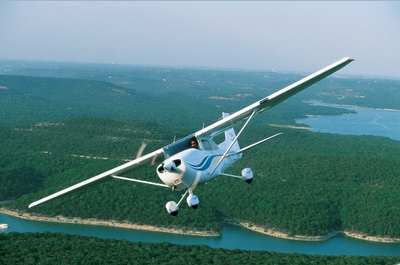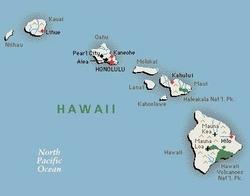Pilot Was On Personal Sightseeing Flight; Insisted Backpack
Remain Behind
 A factual report released this week
by the National Transportation Safety Board on a 2005 rented Cessna
172 crash indicates the aircraft was operating normally when it
impacted a ridge at 2,300 feet near the Hana, HI Airport. As previously reported by
ANN, the Cessna 172 had been rented by the pilot while
visiting the islands from Utah, when it went down on the tropical
mountainside of a dormant volcano.
A factual report released this week
by the National Transportation Safety Board on a 2005 rented Cessna
172 crash indicates the aircraft was operating normally when it
impacted a ridge at 2,300 feet near the Hana, HI Airport. As previously reported by
ANN, the Cessna 172 had been rented by the pilot while
visiting the islands from Utah, when it went down on the tropical
mountainside of a dormant volcano.
Conditions at Kahulai Airport, the nearest reporting point, were
VFR at the time of the incident, according to the FAA Preliminary
Report.
From the parts of the engine and fuselage recovered,
investigators determined there was no apparent problem with the
flight controls and the engine appeared to have been operating
normally with a small amount of fuel found in the fuel pump.
According to the Salt Lake Tribune, firefighters were called at
approximately 3:55 pm Thursday, December 15, 2005 when smoke was
seen coming from the remote area.
A helicopter pilot spraying for miconia at 3:50 pm in the area
above Hana noticed smoke rising from the ridge and found what
turned out to be the Cessna 172 the pilot had taken out just after
noon that day from Kahulai Airport, according to The Maui News.
The family of the pilot, Alan Gerow, 58, of Salt Lake City,
reported they had noted nothing unusual in the weeks before the
crash. He was vacationing alone.
Gerow told the CFI with Maui Aviators who checked him out in the
172 he wanted to do a personal air tour of the island, and had
reserved the plane for both December 15 and 16. The flight
instructor reported that Gerow was a competent pilot but said his
"communications skills were rough."

The day of the accident, Gerow gave the CFI a pair of leather
gloves and insisted on leaving his backpack at the flight center,
although the instructor told him the center would be closed by the
time he returned, according to the report. After a lengthy
discussion, the CFI allowed the backpack to be kept in the terminal
to be retrieved the following day.
The CFI listened as Gerow received clearance and took off.
Shortly after departure, Gerow made an incorrect left turn and
corrected after some confusion. During this time, Kahului
controllers were not receiving the transponder. Gerow performed a
closed-pattern flight and, on the downwind leg of the traffic
pattern, the tower verified the transponder was functioning
properly.
 After the crash, Maui police
recovered the backpack and found rental car keys, his wallet,
binoculars, camera, five to six small bottles of liquor, several
containers of pills and other personal belongings. The CFI did not
smell alcohol on Gerow prior to departure.
After the crash, Maui police
recovered the backpack and found rental car keys, his wallet,
binoculars, camera, five to six small bottles of liquor, several
containers of pills and other personal belongings. The CFI did not
smell alcohol on Gerow prior to departure.
The helicopter pilot who originally located the wreckage told
the NTSB the direction of flight was not consistent with normal
approach or departure from Hana Airport, Gerow's destination -- and
would ensure eventual impact with the rising terrain.
Gerow's brother told the NTSB the pilot lived alone, was a
private person and worked in sales. He aspired to be a commercial
pilot, but had been unsuccessful.
A toxicology report found small amounts of ethanol and
chlorphenrine in Gerow's system. Chlorphenrine is an antihistamine
commonly prescribed for allergies. Gerow suffered from allergies,
according to his brother. The ethanol could have been from
postmortem biological effects.
No logbooks have been located. Gerow held a commercial
certificate, was authorized to fly single and multi-engine
aircraft, and held an instrument rating. On his third-class medical
application on February 15, 2005 he listed 570 total hours with no
flight time in the previous six months.
On the rental disclosure, Gerow listed 541 total hours, 97 hours
in the previous 90 days and 35 hours in a 172. His last biennial
flight review was listed on April 21, 2005.
 ANN's Daily Aero-Term (04.24.24): Runway Lead-in Light System
ANN's Daily Aero-Term (04.24.24): Runway Lead-in Light System ANN's Daily Aero-Linx (04.24.24)
ANN's Daily Aero-Linx (04.24.24) Aero-FAQ: Dave Juwel's Aviation Marketing Stories -- ITBOA BNITBOB
Aero-FAQ: Dave Juwel's Aviation Marketing Stories -- ITBOA BNITBOB Classic Aero-TV: Best Seat in The House -- 'Inside' The AeroShell Aerobatic Team
Classic Aero-TV: Best Seat in The House -- 'Inside' The AeroShell Aerobatic Team Airborne Affordable Flyers 04.18.24: CarbonCub UL, Fisher, Affordable Flyer Expo
Airborne Affordable Flyers 04.18.24: CarbonCub UL, Fisher, Affordable Flyer Expo





